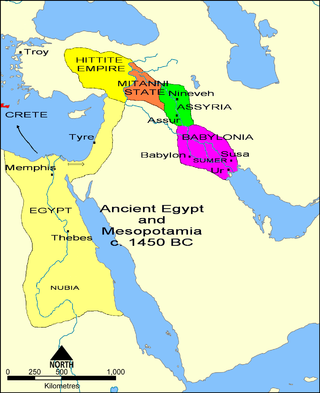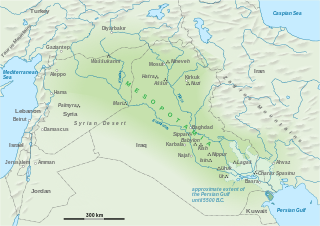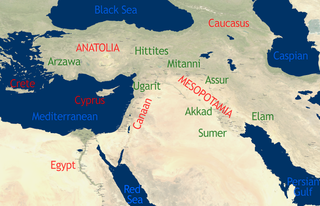Events and trends
| | This section is empty. You can help by adding to it. (May 2015) |
The 1640s BC was a decade lasting from January 1, 1649 BC to December 31, 1640 BC.
| Millennium |
|---|
| 2nd millennium BC |
| Centuries |
| Decades |
| Years |
|
| Categories |
| | This section is empty. You can help by adding to it. (May 2015) |

The 15th century BC was the century that lasted from 1500 BC to 1401 BC.
The 16th century BC was a century that lasted from 1600 BC to 1501 BC.

The 17th century BC was the century that lasted from 1700 BC to 1601 BC.
The 18th century BC was the century that lasted from 1800 BC to 1701 BC.
The 1690s BC was a decade lasting from January 1, 1699, BC to December 31, 1690, BC.

Babylonia was an ancient Akkadian-speaking state and cultural area based in the city of Babylon in central-southern Mesopotamia. It emerged as an Akkadian populated but Amorite-ruled state c. 1894 BC. During the reign of Hammurabi and afterwards, Babylonia was retrospectively called "the country of Akkad", a deliberate archaism in reference to the previous glory of the Akkadian Empire. It was often involved in rivalry with the older ethno-linguistically related state of Assyria in the north of Mesopotamia and Elam to the east in Ancient Iran. Babylonia briefly became the major power in the region after Hammurabi created a short-lived empire, succeeding the earlier Akkadian Empire, Third Dynasty of Ur, and Old Assyrian Empire. The Babylonian Empire rapidly fell apart after the death of Hammurabi and reverted to a small kingdom centered around the city of Babylon.

The Kassites were people of the ancient Near East, who controlled Babylonia after the fall of the Old Babylonian Empire c. 1531 BC and until c. 1155 BC.

Mitanni, earlier called Ḫabigalbat in old Babylonian texts, c. 1600 BC; Hanigalbat or Hani-Rabbat in Assyrian records, or Naharin in Egyptian texts, was a Hurrian-speaking state in northern Syria and southeast Anatolia with Indo-Aryan linguistic and political influences. Since no histories, royal annals or chronicles have yet been found in its excavated sites, knowledge about Mitanni is sparse compared to the other powers in the area, and dependent on what its neighbours commented in their texts.

The history of Mesopotamia ranges from the earliest human occupation in the Paleolithic period up to Late antiquity. This history is pieced together from evidence retrieved from archaeological excavations and, after the introduction of writing in the late 4th millennium BC, an increasing amount of historical sources. While in the Paleolithic and early Neolithic periods only parts of Upper Mesopotamia were occupied, the southern alluvium was settled during the late Neolithic period. Mesopotamia has been home to many of the oldest major civilizations, entering history from the Early Bronze Age, for which reason it is often called a cradle of civilization.
Artatama I was a king of the Hurrian kingdom of Mitanni in the late fifteenth century BC. His reign coincided with the reigns of Egyptian pharaohs Amenhotep II and Thutmose IV. He is believed to be the son of earlier Mitanni king Shaushtatar.

The chronology of the ancient Near East is a framework of dates for various events, rulers and dynasties. Historical inscriptions and texts customarily record events in terms of a succession of officials or rulers: "in the year X of king Y". Comparing many records pieces together a relative chronology relating dates in cities over a wide area.
The Kingdom of Khana or Kingdom of Hana was the Syrian kingdom from Hana Land in the middle Euphrates region north of Mari, which included the ancient city of Terqa. The kingdom emerged during the decline of the First Babylonian Dynasty. A newer view is that only the initial six rulers lived during that time and that after an interregnum, Khana re-emerged in the Middle Babylonian period under the last six kings. The Low Chronology dating scheme for Hana has gained much support. The kingdom was located in the middle Euphrates close to the junction of Khabur River. Its capital was the town of Terqa.

The timeline of ancient Assyria can be broken down into three main eras: the Old Assyrian period, Middle Assyrian Empire, and Neo-Assyrian Empire. Modern scholars typically also recognize an Early period preceding the Old Assyrian period and a post-imperial period succeeding the Neo-Assyrian period.

The Middle Babylonian period, also known as the Kassite period, in southern Mesopotamia is dated from c. 1595 – c. 1155 BC and began after the Hittites sacked the city of Babylon. The Kassites, whose dynasty is synonymous with the period, eventually assumed political control over the region and consolidated their power by subjugating the Sealand dynasty c. 1475 BC. After the subjugation of the Sealand dynasty, the Kassites unified the region of Babylonia into a single political entity. At the height of the Middle Babylonian period, the Kassite kings were engaging in commerce, trade, and organising diplomatic marriages with the kings of Egypt and other regional powers. However, after a period of gradual decline, the Middle Babylonian period collapsed with the fall of the Kassite dynasty c. 1155 BC. The collapse came as a result of an Assyrian invasion, that temporarily displaced the Kassites from their rule over southern Mesopotamia. Finally, the Elamites conducted various raids and eventually invaded Babylonian c. 1158 BC, which brought the Kassite dynasty and Middle Babylonian period to an end.